Turbulent Times: New South Wales in the 1890s
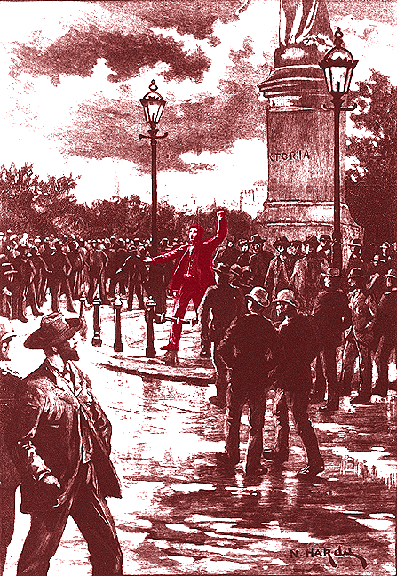 Strike Meeting at Queens Square in Macquarie Street, Sydney, 1890s
Strike Meeting at Queens Square in Macquarie Street, Sydney, 1890s
The 1890s were a testing time throughout the eastern Australian colonies. Although 66% of population of New South Wales now lived in urban centres, the economy was heavily dependent on agricultural exports. The long economic boom which began with the gold rushes of the 1850s and which had greatly increased local manufacturing and fed speculation in the 1880s, began to collapse, beginning with Victorian property collapses and a British banking crises. Overseas investment dried up; prices for wool and wheat fell dramatically. Most local banks collapsed costing many depositors their funds. Unemployment and poverty soared, government tax revenues collapsed and public works projects were abandoned. To make matters even worse a long drought began, further damaging the rural industries on which most colonies depended.
The 1880s had seen great advances amongst trade unionism which had become sufficiently strong to express their frustrations effectively and to cause alarm amongst employers. In late 1890 a massive national maritime strike erupted when employers refused to negotiate: the strikers on ships and the waterfront were supported by coal miners, transport and agricultural workers. A six month shearer's strike followed, beginning in Queensland in January 1891 when pastoralists cut wages and employed non-union labour. This soon spread throughout New South Wales and Victoria was particularly bitter and violent, bringing near warfare conditions to rural areas. Both major strikes were lost by the unionists although others, such as that by the Broken Hill Miners, had successes. It was both a contribution to and result of the economic conditions. Australia had been increasingly seen as the working man's paradise but the 1890s challenged that view. One response to the resulting disillusionment was the New Australia movement led by William Lane which attempted to create a utopian society in Paraguay in 1893. Despite the industrial reverses, the 1890s fostered the rise of socialism, the Labor Party, nationalist and even republican sentiment. Magazines such as The Bulletin and by emerging "AustralIan" schools of art (such as the Australian impressionists Roberts, Streeton, etc) and writing (Henry Lawson, "Banjo" Paterson and others) contributed to an emerging national sentiment.
In such times, concerns about the possible immigration of cheap (and non-European) labour grew: one concern being with the "kanaka trade", the importing (or virtual kidnapping) of Pacific Island labourers into the Queensland sugar canefields. There was also increasing concern about the growing strength of Japan and the imperial activities of German and France in the Pacific.
Electoral Reform
In this period, some of the significant achievements already made in the democratic system in New South Wales were consolidated. One achievement was payment for members of parliament. From 1889 until 1960 New South Wales Members were paid what was termed as "Parliamentary allowances". Previously only men of independent means could afford to be members of parliament, but from 1889, workers and men from all quarters could afford to be members of parliament. This had a particular significance for the emerging Labor Party.
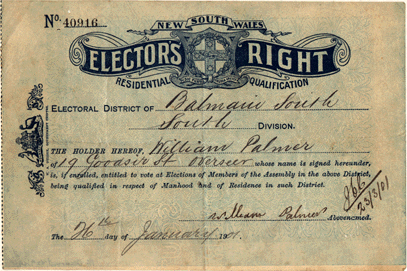
In 1893 plural voting was abolished. Prior to that, some voters, through property ownership or through being university graduates, had more than one vote. From this time, the principle was espoused of "One man, one vote". Similarly (although this was to be changed again for a while in the 1920s) all electorates were to be represented by a single member.
By the end of the nineteenth century almost all adult males could vote, even if not all exercised that right - voting was not made compulsory until 1929. At least two great inequities remained. Despite the effective voice of a growing women's suffrage movement in the 1880s and 1890s, women could not yet vote in New South Wales and, although not legally denied the right to vote in New South Wales, Aboriginal people were effectively disqualified through a range of discriminatory regulations and practices.
The Emergence of Political Parties
In the last decade or so of the nineteenth century, a period which began with a severe economic depression, several new factors began to dominate political life.
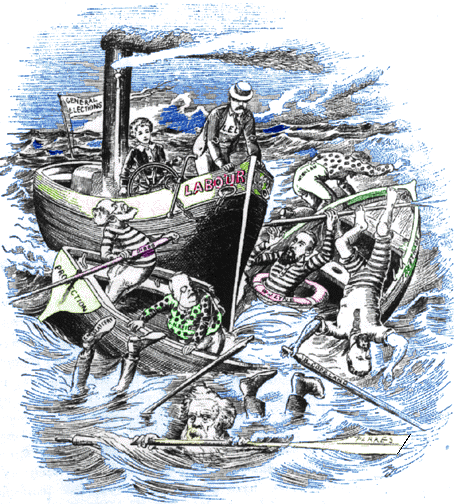
Political Parties began to emerge. By 1889 the opposing Free Trader and Protectionist factions were forming what was, in effect, the first full-scale "party" organisation in New South Wales, and Sir Henry Parkes’ last Ministry (1889 -1891) was Free Trade party government. He was succeeded by Sir George Dibbs’ Protectionist government of 1891-1894 and then the Free Traders again under George Reid (1894 -1899).
In the 1891 election, 35 members of the newly formed Labor Electoral League entered Parliament although they split almost immediately over the protection-free trade issue. Their numbers were significant but not sufficient for Labor to form a government until 1910.
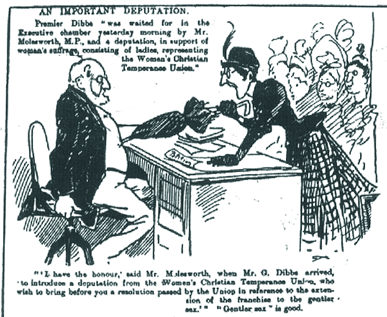
[
The Women's Suffrage Movement - The Bulletin, 1894. A typical media portrayal of the women's suffrage movement. Premier George Dibbs is confronted in his office by "ladies representing the Women's Christian Temperence Movement".
The New South Wales Female Suffrage Movement had its origins in the late 1880s, led initially by organisations such as the Women's Christian Temperance Union and such women as Elizabeth Ward. The newspaper, "The Dawn", published by Louisa Lawson (the mother of writer, Henry Lawson) added to the voices for justice for women. The New South Wales Womanhood Suffrage League was formed in 1891, bringing to prominence the activist Rose Scott and other important campaigners such as Maybanke Wolstenholme and Dora Montefiore.
The movement was greatly spurred on when New Zealand became the first country in the world to grant women the right to vote, in 1893, and South Australia followed in 1894-1895, also allowing women to stand for election to both Houses of Parliament on the same terms as men.
In New South Wales several bills for female suffrage were proposed between 1891 and 1901, generally being passed in the Lower House but defeated in the Upper House. Despite widespread ridicule of the idea of women being involved in politics, especially by the media, the movement gathered momentum and by the dawn of the new century was less than two years away from success.
First Moves Toward Federation
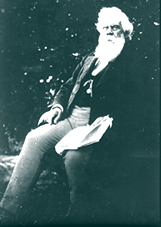
Sir Henry Parkes, veteran New South Wales Premier whose 1889 Tenterfield speech and personal energy was the catalyst for the revived Federation movement | 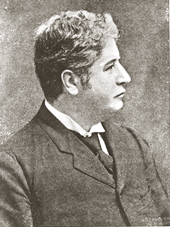
Edmund Barton, former Speaker of the New South Wales Legislative Assembly, a leader of the federation movement and, in 1901, Australia's first Prime Minister |
Although there had been many proposals involving the bringing together of the separate Australian colonies into a single nation and a largely ineffectual Federal Council was set up in 1885, it would have seemed highly improbable in 1889 that a federation of the six colonies was only 12 years away.
Differences over trade (whether free or protectionist) and the resulting customs and border posts; transport (the colonies had adopted different railway gauges) separated the colonies. However, it was also seen that federation could be a way of resolving these problems.
However, there were also compelling reasons supporting some form of federation. The colonies shared a predominently Anglo-Celtic culture, institutions and outlook: there was relatively little difference between them. Major-General Edwards' 1888 defence report demonstrated that adequate defence of the continent would be impossible without combining their forces. Most of the colonies were also concerned about immigration and could see the advantages of a common policy.
In 1889, New South Wales Premier Sir Henry Parkes, set a new federation campaign moving in a speech made at Tenterfield in New South Wales in October, 1889. In February, 1890, the colonial premiers met in Melbourne. They agreed to call a convention the following year.
In March, 1891, 46 delegtes from all the Australian colonies and New Zealand, met in the Legislative Assembly Chamber of the Parliament of New South Wales and, in the course of the meeting, the first draft constitution for Australia was drawn up. The proposed constitution was partly inspired by the Canadian federal example, but adopted key elements of the American federal model, the Swiss referendum process for changing it, and retained the essential elements of the British Westminster model of parliament and government.
However, after the return of the delegates to their respective colonial Parliaments, little progress took place. The Federation momentum was revived by a conference of people's federal leagues in Corowa in 1893 and the leaders who now emerged were New South Wales' Edmund Barton and Victoria's Alfred Deakin, along with Dr John Quick who suggested the way forward. At a meeting in Hobart in 1895, the Premiers generally adopted Quick's proposals and further Constitutional Conventions were held in Adelaide and Sydney (in 1897) and Melbourne (1898), finalising the form of the constitution and agreeing on the refendum process that was to follow. Popular support was now being demonstrated. Another people's convention had been held at Bathurst in1896 and smaller scale public meetings were widely held.
Achieving Federation
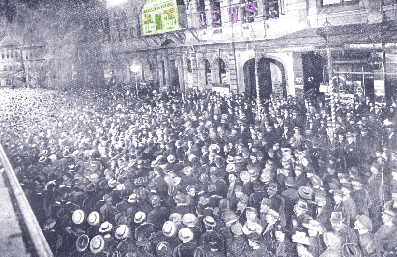 One of the huge crowds which gathered outside Sydney newspaper offices in 1899 to watch the results of the second Federation Referendum on display boards
One of the huge crowds which gathered outside Sydney newspaper offices in 1899 to watch the results of the second Federation Referendum on display boards
Having decided on the form of the Australian Constitution, the process chosen for adopting it was unusually democratic for the time, although not perhaps for Australia where democratic institutions were more advanced than almost anywhere else. However, the final step also reflected the continuing colonial status of Australia. Despite strong and growing nationalism, federation was in no way an attempt to depart from British influence, although, inevitably, that was the long term result.
In 1898 popular referendums on the proposed constitution were held in New South Wales, Victoria, South Australia and Tasmania. All were successful, but the NSW government, under Premier George Reid (popularly known as "yes-no Reid" because of his ambivalence over federation) had set a requirement for a higher "yes" vote than just a simple majority, and the necessary majority was not reached.
In 1899, the Premiers met again in Sydney, and several amendments were made to satisfy concerns in New South Wales and Queensland. Another referendum was held in Queensland, New South Wales, Victoria, Tasmania and South Australia and the proposition was passed with increased majorities. Federation was on its way.
However, no referendum had been held in Western Australia, where there was concern that the financial arrangements would disadvantage the colony. The proposed Constitution was now taken to the British parliament at Westminster where it was debated, passed and signed into law by Queen Victoria in June, 1900.
Western Australia was either not referred to in the Constitution, or listed conditionally, "should it choose to join".
In June, after the British Parliament had already passed the Constitution Act, Western Australia held its referendum which also succeeded, mainly because of the large yes vote from the Kalgoorli goldfields. On January 1, 1901, the Commonwealth of Australia was proclaimed in Sydney and celebrated throughout the new nationmade up the six former colonies, now states. The new Federal Parliament was to meet temporarily in Melbourne until a new capital was established in a special Australian Capital Territory located within New South Wales.
